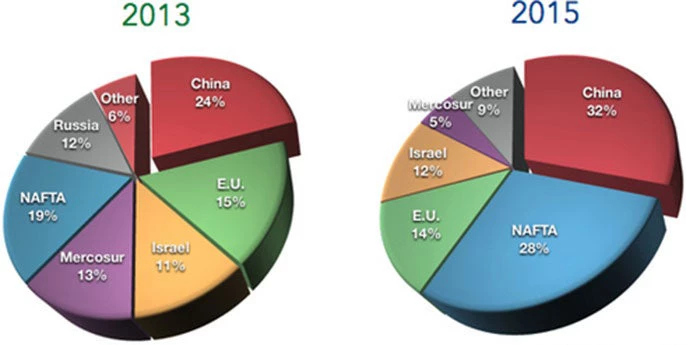
Imagine if you could know where your steak was born, and all of the details about its life until it reached your plate. Since 2011, this has been possible with Uruguay’s national system for livestock information or Sistema Nacional de Información Ganadera (SNIG).
Why 100% traceability of cattle matters
The World Bank aided the development of SNIG, which became fully operational in 2004, as part of its support for Uruguay’s recovery from the Foot and Mouth Disease epidemic. The SNIG, which is a livestock registration system with more than 75,000 participants in the agricultural and industrial sectors, paved the way for Uruguay’s mandatory individual cattle traceability program. All animals born in September 2006 or later are required to be tagged with one visual ear tag and one radio frequency identification tag, both for traceability purposes. The novel system allowed Uruguay to become the only country in the Americas (and one of only a few in the world) with 100% traceability of cattle and allowed consumers, mainly in China, Europe and NAFTA areas to know the origin of the beef for health (fewer diseases with full tractability), social (ability to know that the cows were grass-fed) and environmental (sustainability of natural resources) reasons.
The system, which is free for users and paid for entirely by the government, allows every producer in Uruguay to take part: from farmers with just two cows, to those who have 30,000 head of cattle. In 2014, SNIG received the grand prize in the e-agriculture category at the 2014 World Summit on the Information Society (WSIS).

100% transparency of your food’s environmental impact
Now the Ministry of Agriculture in Uruguay, with support from the World Bank, is taking things a step further to allow not just for 100% traceability of cattle products, but also for 100% transparency of the environmental impacts of both livestock and agriculture on soil, water and forests. This is made possible with the help of the new National System for Agricultural Information or Sistema Nacional de Información Agropecuaria (SNIA). SNIA is a multipurpose web-platform that includes SNIG’s information and consolidates data such as forecasts and early-climate warnings.
Although SNIA has not yet fully launched, the databases are already helping farmers and cattle ranchers mitigate the impacts of weather events on their production. The system as such has started to function as a climate service resource for decision making. Using several SNIA climate-related products (i.e. vegetation indexes, soil water availability, and standard precipitation indexes, among others) to develop water-related risk indices maps, Uruguay’s Agriculture Ministry was able to predict a drought last May and declare a 90-day drought emergency for dairy farmers and cattle ranchers within seven departments of the country. This declaration allowed meat and dairy producers in affected departments access to funds from the Emergency Agriculture Fund to buy grains for the animals and other supplies.
New markets for Uruguay’s agricultural exports
The World Bank-funded SNIG and SNIA platforms have also opened up new markets for Uruguay’s agricultural products. Because Uruguay’s livestock industry can now collect accurate information about their beef products, they are able to meet the standards for USDA verification. On September 4 th, 2015, Uruguay delivered its first shipment of natural raised, certified beef to the United States, complete with the USDA verification: the Never Ever 3 label. Uruguay is the only foreign country to receive the USDA’s Never Ever 3 designation. The label requirements are stringent: No Antibiotics can be administered whether through feed, water, or by injection, from birth to slaughter. If animals require antibiotics for treatment of illness, they must be treated and removed from the program. No Growth Promotants; the administration of growth hormones, including natural hormones, synthetic hormones, estrus suppressants, beta agonists, or other synthetic growth promotants is prohibited from birth to slaughter. No Animal By-Products; mammalian and avian by-products are not allowed (including animal waste, meat and fat). Fish and vitamin and mineral supplements are permissible.
With the incorporation of the SNIA system, it will soon be possible to not only trace Uruguayan beef, but also track its environmental impact. Imagine, an order of sustainably produced, 100% traceable Uruguay meat—it might not be too long before this vision is a reality.



Join the Conversation